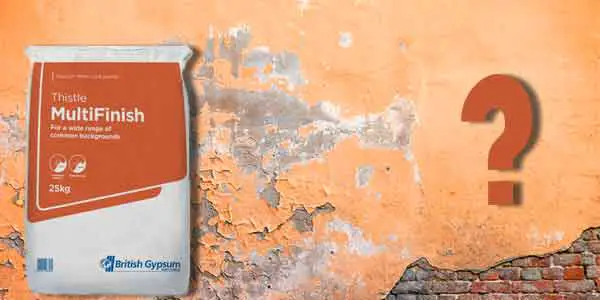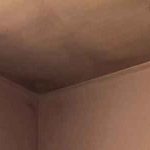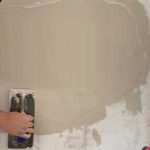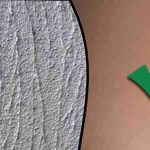In this article, we will be looking at several different types of paint and whether it is possible to skim plaster over them. The aim is to provide you with a guide, that will enable you to make an informed decision when it comes to skimming plastering.
It might be tempting to just plaster over any paint. However, there are a number of considerations to make. Depending on the type of paint, you might need to carry out prep work. This will make sure that the plaster bonds to the wall and stays in place.
If the paint is cracked, blown, flaking, or bubbling, then you will need to remove it. Should the paint be in perfect condition, you can take the necessary steps to skim directly over it.

Can you skim over emulsion?
If your walls and ceilings have been painted with emulsion paint, it is possible to skim over it if the surface is in good condition.
Emulsion paint is the most common paint used in the UK. Its generally used on ceilings and walls around the home. Therefore, when it comes to over-skimming, you will usually find that emulsion is the surface you are plastering onto. This paint is water-based with the addition of vinyl and acrylic to improve durability. It comes in a number of finishes that either give the paint a sheen or a matt finish.
When plastering over any surface, it is important that it is in good condition. This means, it is especially important to thoroughly check the surface for imperfections. If you choose to skim over emulsion paint, it has to have a solid bond to the subsurface, as this will ensure that the plaster doesn’t come away from the walls.
If there are problem areas, you’ll need to remove the paint by either scraping or sanding it. This will take effort and time, but it will enable you to plaster over the subsurface, giving a solid finish.
Should the paint be in good condition, you can carry on with the prep work. The aim is to prime the surface, so it has a good key. You have two options:
- Lightly score the paint. This is a quick and easy process
- Give your walls a coat of blue grit. This will take slightly more effort, but will give you a solid key.
Can you skim over gloss?
If the surface is in a suitable condition, it is possible to skim over gloss paint.
Traditionally, gloss paints have been oil-based, but water-based gloss is now becoming more popular due to its flexibility. In most cases, it is possible to skim over gloss paint, providing the paint is in good condition.
Where oil based gloss is failing, you will need to use sandpaper a sander to remove it. For water-based gloss, you can use a scraper and sandpaper. This can be time-consuming, but it is worth doing as this will enable you to skim plaster over a solid subsurface.
If the walls are in good condition, then you can plaster over gloss, but you’ll need to carry out prep work first. As the gloss has a sheen finish, you’ll need to make sure that you create a key. This will give the plaster something to adhere to.
To create a key, after sanding, it is recommended that you apply a coat of PVA and wait for that to go tacky. Once it gets tacky, you can then apply your skim coat of plaster. If you prefer to carry out more prep work, you can apply a coat of blue grit, giving your walls a better key that the plaster can grip to.
Can you skim over masonry paint?
Masonry paint can be skimmed over, but again it’s important to carry out the correct prep work beforehand. Masonry paint is designed for use on stone, brick, concrete, plaster, and many other surfaces. It is a highly durable paint that is acrylic-based.
If the paint is not in a poor condition, then you will need to remove it. This might be possible using a scraper. However, if the paint is still firm in places, you may need to use a heavy-duty paint stripper and laminated paint removal strips.
This is a job that takes some time, as the paint stripper needs to be applied before the strips are then placed on top. The strips can then be removed after the allocated time has passed, bringing the masonry paint with it.
If the masonry paint and walls are in a solid condition, then you’ll need to prepare them correctly. You’ll need to apply a bonding agent, as this will ensure there is no suction from the subsurface, preventing moisture from being drawn out of the plaster. Apply one coat of PVA or bonding agent and when this is tacky, you can then skim plaster.
Can you skim over distemper paint?
It is possible to skim over distemper paint, but you will need to carry out the right prep work. Distemper is an old paint that is often seen in older properties, it has a chalky consistency. This consistency is the reason it is not possible to skim directly over it.
As plaster needs a solid surface to bond to, you’ll need to make sure the chalky finish that comes with distemper paint is completely removed or dealt with correctly.
There are a number of options available, and they take time and effort but will give you a good base to skim over. This includes:
- Scrubbing the walls with hot water or a wallpaper steamer to soften the distemper before scraping it off.
- It is also possible to coat the paint with wallpaper paste. The paint will soak up the paste causing it to soften, enabling you to scrape it off using a scraper.
If you decide that you don’t want to completely remove the paint, you do have the option of sealing it. However, you will need to thoroughly wash the walls with hot water to remove the dust. It is then possible to apply a coat of PVA, Artex sealer or other sealing products before skimming.
Conclusion
So, as you can see, it is possible to skim over the different paints we have covered above. However, the recommendation is that you thoroughly check the surfaces for problems and remove them where necessary. The aim is to make sure that you have a strong surface that is suitable for the skim coat.
If you fail to carry out the right preparation, there is a chance that your skim plaster might fail. If the plaster does fail paint could weaken and come away from the wall. This is why it is so important to spend time on the prep work, to ensure the perfect finish.




